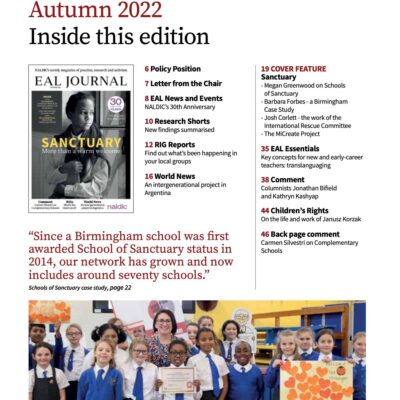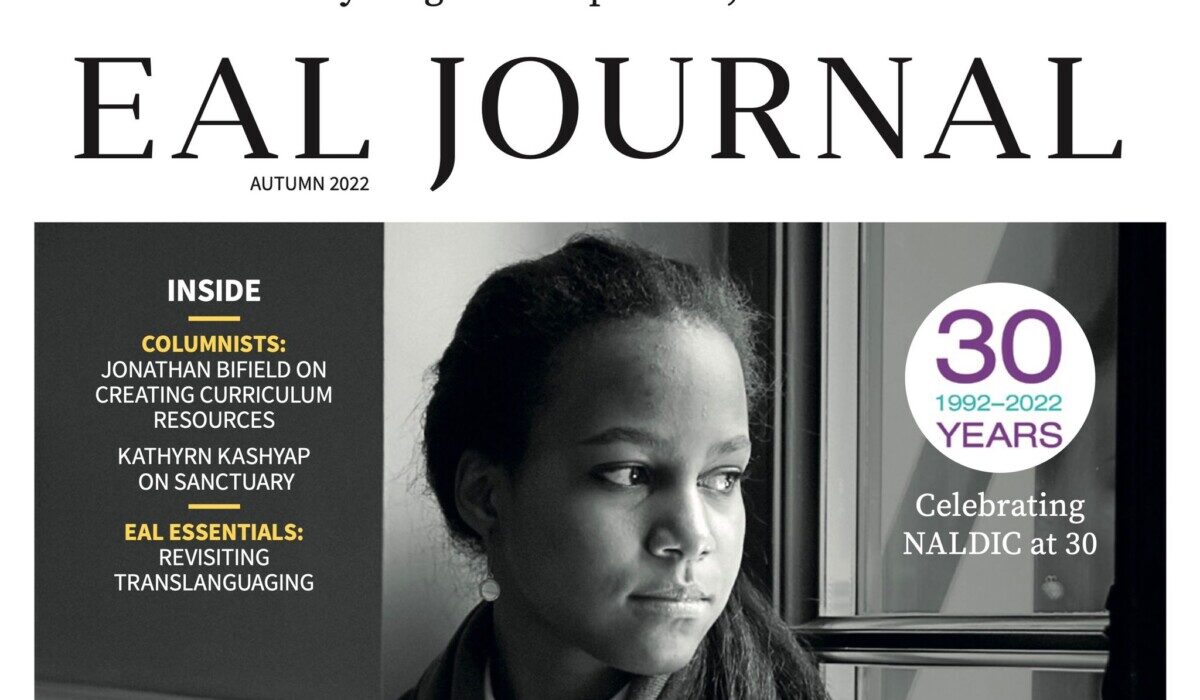Christina Richardson, EAL Journal Editor-in-Chief, shares news about the latest issue of the EAL journal
Any day now, the latest issue of the journal will be landing on doormats and on staffroom tables across the country! It will reach our international members in the next few weeks. The cover theme for the journal is Sanctuary and we are pleased to bring you a series of articles guest edited by Sara Trewhitt and Megan Greenwood from Schools of Sanctuary. As well as offering insights into the work of the Schools of Sanctuary, including a case study, the cover feature shares the work of the International Rescue Committee. The fourth article in the cover feature looks at the work of the MiCreate project group.
Click here to watch the full interview with Sara Trewhitt from the School of Sanctuary
The Journal will, of course, bring you its regular series such as EAL Essentials (this issue will be on translanguaging) and our Children’s Rights series. Look out for our regular columnists, Jonathan Bifield and Kathryn Kashyap and don’t miss Carmen Silvestri’s back page comment on complementary schools. The RIG Reports offer insights into the vital work of the Regional Interest Group. You can find the programme of events on our website to join the next RIGs meetings. Finally, the Research Short provides useful short summaries of research papers, invaluable for researchers of all kinds and to our EAL community more broadly.

A sneak peek of the latest journal is available in Insta Stories on our Instagram account. A massive thanks to deputy editors, Rachel Knowles and Leandro Paladino for their technical wizardry!
Carmen Silvestri reminds us of some of the ground-breaking work that NALDIC has achieved as highlighted by Constant Leung, Publications Chair at NALDIC in an InstaLive conversation with Leo Paladino, Deputy Editor
When Leo asks how did it all start, Constant remembers the beginning of NALDIC in the 1990s. He starts by saying that “what happened then was that linguistic and ethnic diversity in society was very much an issue and there was, as it is now really, very little in the school curriculum that was specifically catering for students from diverse language backgrounds”. He delves into the terminology issue and remind us that “English then was referred to as English as a second language. So the term EAL wasn’t used until a few years after the inception of NALDIC. But was already in the air that there were issues related to both the terminology and also the curriculum provision”. He tells about the teachers who were already teaching in classrooms with students from diverse backgrounds but since there was no systematic response in terms of provision for students of English language, they thought it was important to “raise the issue to the surface”. Though, it was always at the school level.
This is when a group of practitioners and researchers started thinking about “forming a national, professional association for people to come together and share their understanding” and so, he adds, “we spent a year or so meeting teachers in different parts of the country at weekends. We would go down the motorway at weekends to meet people and try to canvas opinions, and it became clear that we had a lot of support and people felt the same. We came together and started a professional teachers association”. And here we are thirty years later!
Yet, he reminds us that the issue of education responding to language and ethnic diversity has intensified. Constant says “if you go back ten years before the pandemic, there was a 1% increase in the number of students from diverse language backgrounds. One percent every year for ten years in succession. It’s a kind of trend that has been growing. And as NALDIC we have been raising the issue over time and trying to bring ideas to our professional discussion through the journal and other channels”.
Among the issues that teachers encountered over the years, is assessment which is one of the main research interests of the Publications Chair who reminds us of the brilliant work of The Bell Foundation. The organisation created an assessment framework that serves as a guide for practitioners working with EAL students and it is free to download. Finally, Constant remembers the challenges around supporting refugees and asylum seeker children in UK schools, especially after the conflict in Ukraine, and says “this is not the first time that we have new arrivals from a conflict zone. What would be really important for schools is to be always tuned and sensitive to the needs of the new arrivals”.
Click here to watch the full interview with the Publications Chair


